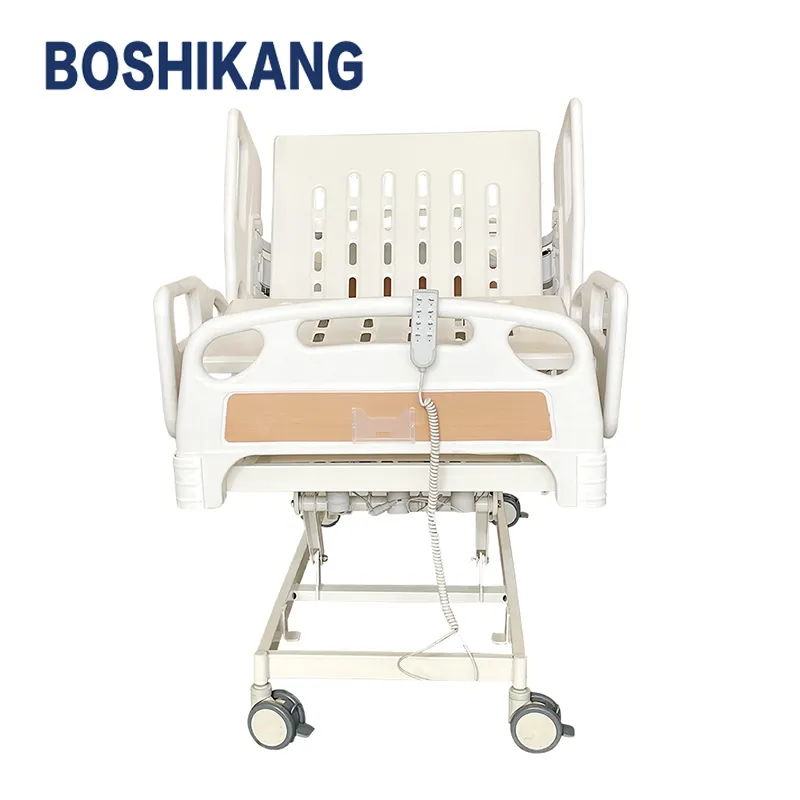Understanding Electric Beds and Their Core Benefits
How Electric Beds Improve Patient Comfort and Safety
Electric beds really boost patient comfort because they let nurses adjust positions all over the place, something that helps prevent those nasty pressure sores we see so often. Research from several hospitals shows when patients can get their beds into just the right position for them, they tend to be happier overall, which makes sense why more facilities are investing in these models. The safety stuff matters too. Most modern electric beds have those side rails that pop up automatically, plus the whole bed can be raised or lowered depending on what works best for each person. Some newer models even include weight sensors underneath the mattress surface. These sensors basically tell staff if someone starts moving around too much at night, giving caregivers time to check on things before a fall happens. All these bells and whistles mean electric beds aren't just comfortable anymore; they actually help keep patients safer across different care environments.
Key Differences Between Manual and Electric Hospital Beds
Hospital beds powered by electricity come with automated controls for adjusting positions, something manual beds lack since they need actual physical effort to move around. Caregivers report spending about half as much time getting patients into different positions when using electric models according to various industry reports, which makes sense given how much work it takes otherwise. Electric beds also provide far more options for adjustment compared to traditional ones. They allow changes to head position, foot elevation, and overall bed height, meeting many different medical requirements that would be impossible with basic manual beds constrained by their simple mechanical designs. When looking at all these factors together, it becomes clear why so many facilities have switched to electric beds recently. They make life easier not just for patients who need frequent repositioning but also for staff dealing with heavy lifting tasks day after day.
Critical Features to Evaluate in Electric Beds
Adjustable Positioning Options for Therapeutic Support
Looking at different positioning options matters a lot when it comes to giving proper therapeutic support, which affects how comfortable patients feel and the quality of their care overall. Hospital beds with multiple adjustable zones meet various treatment requirements, letting nurses set positions that help relieve pain and speed up recovery times. Studies show these adjustable features really cut down on pain after surgery, making them crucial for getting better faster. Electric models typically come with memory functions too, so staff can save favorite positions for regular users. This saves time and makes daily care routines much smoother for everyone involved.
Safety Mechanisms: Locking Systems and Weight Capacity
The safety features built into electric hospital beds matter a lot when it comes to accident prevention and keeping patients safe. Those locking mechanisms stop the bed from moving unexpectedly, something that really matters when transferring patients or during regular adjustments throughout the day. Knowing what weight limit the bed can handle is just as important because going over that limit tends to cause all sorts of mechanical problems down the road. Studies show that beds equipped with good locking systems actually cut fall incidents almost in half sometimes around 30% according to some research. When choosing equipment for healthcare settings, looking at these safety aspects makes sense not just for protecting patients but also for safeguarding staff members who work closely with them every day. A secure setup creates peace of mind for everyone involved in patient care.
Assessing Patient Needs for Electric Bed Selection
Picking out an electric bed starts with getting a good grasp on how mobile (or not) the patient actually is. Beds with adjustable heights and those side rails make all the difference for folks dealing with different health issues, really opening things up for people who struggle with movement. The freedom these features provide matters a lot too. Studies show that when patients feel they have control over their surroundings, it does wonders for their mental state. After all, nobody wants to feel trapped in bed all day. Getting the configuration right isn't just about comfort either. Doctors see better recovery rates when beds match what patients need physically while also supporting their emotional well being during hospital stays or at home care situations.
Mobility Challenges and Customizable Bed Configurations
Adjustable bed setups make all the difference when dealing with different mobility issues. Features like changing the bed height or adding side rails really help people get in and out safely no matter what their mobility level is. Electric beds let caregivers tweak these settings so they fit each person's particular medical needs, which makes sleeping and resting much more comfortable for everyone involved. Research backs this up too many hospitals report better recovery rates when patients have beds they can adjust themselves. Patients feel more independent when they can control their own space, and this autonomy actually boosts their mental health over time. When someone can reach for a glass of water without asking for help or position themselves comfortably during rest periods, it creates that important feeling of being in charge of one's own situation, which definitely improves day to day living experiences.
Long-Term Care Requirements vs. Short-Term Use
Figuring out if an electric bed will be used for long term care versus short term rehab really matters when making a purchase decision. The ones meant for extended stays tend to last longer and come packed with extra features patients need day after day. Think about things like adjustable positions, pressure relief systems, and easier access points for caregivers who spend hours helping someone get comfortable. On the flip side, beds bought for temporary situations often focus on keeping costs down while still doing the basics right. They handle short hospital stays or recovery periods without breaking the bank. Research into how different beds affect actual patient results shows pretty big gaps between performance levels depending on which type gets chosen. So knowing exactly how long someone needs the bed helps narrow down options and match equipment specs to what the person actually requires during their treatment journey.
Budget Considerations and Cost-Effective Solutions
Buying New vs. Renting: Long-Term Value Analysis
Figuring out whether buying or renting an electric bed makes better financial sense is something most people overlook when they need one. Buying definitely costs more at first glance, but over time those payments add up less than continued rental fees if someone plans on using the bed long term. For folks who only need temporary assistance during recovery periods, renting often works out cheaper according to various industry reports showing average monthly rates versus purchase prices. The decision shouldn't just focus on initial expenses though. Things matter like how much the bed will lose value over years, regular upkeep requirements, and whether there's any chance of selling it later on. Most advisors tell patients to actually write down all expected costs against benefits before choosing either path. Getting this right means saving money in the long run while still getting proper support from whatever solution fits individual circumstances best.
Hidden Costs: Maintenance and Accessory Expenses
Most people forget to include maintenance costs and needed accessories when budgeting for electric beds, which leads to unexpected spending down the road. Keeping these beds running properly requires regular upkeep that goes beyond just occasional checks. Failure to maintain them according to manufacturer guidelines often results in warranty issues and expensive fixes later on. Healthcare facility managers report that around 15 to 20 percent of all electric bed expenditures actually come from these so-called hidden costs. When shopping for one of these beds, it makes sense to look at maintenance requirements and consider items such as protective mattress covers or safety rails upfront. Taking the time to account for these additional expenses helps protect against financial surprises and keeps the bed functioning well throughout its lifespan.

Caregiver-Friendly Design in Electric Beds
Ergonomic Features for Reduced Caregiver Strain
When looking at electric beds, one thing stands out right away - they're built with caregiver comfort front of mind. The whole point is to make life easier for those who spend hours lifting and moving patients around. Take adjustable height settings for example. These aren't just nice to have features. Research shows about six out of ten caregivers deal with back pain from doing all this heavy lifting manually. So when hospitals invest in beds with proper ergonomic tech, everyone wins really. Caregivers get a safer workplace where their backs don't ache so much after shifts, while patients find it easier to get in and out of bed without assistance. Makes sense then why facilities should seriously think about these ergonomic options before making purchases.
Remote Controls and Ease of Operation
Adding remote controls to electric beds makes things much easier for everyone involved. Caregivers no longer need to stretch across the bed to change positions or settings, which saves time and reduces strain on their bodies. For staff members juggling several patients at once or dealing with difficult cases, this convenience matters a lot. When controls are easy to use, mistakes happen less frequently, and that directly affects how well patients are cared for day to day. Research indicates that when nurses and attendants have access to straightforward remote systems, they can respond faster to patient needs without wasting precious minutes fumbling with complicated mechanisms. The bottom line is clear remote controls aren't just nice to have they're essential components in creating electric beds that actually work for busy healthcare professionals.
FAQ Section
What is the main advantage of electric beds over manual beds?
The main advantage is the automated positioning controls that electric beds offer, providing ease and efficiency in operations compared to manual beds that require physical adjustments.
How can electric beds improve patient safety?
Electric beds improve safety through features like side rails, customizable height adjustments, and built-in weight sensors that help prevent falls and alert caregivers to potential risks.
What should I consider when choosing an electric bed for short-term or long-term use?
Consider the durability and features of the bed. Long-term care beds typically offer advanced features suitable for prolonged use, while short-term beds prioritize cost-effectiveness with basic functionalities.
Why is understanding the hidden costs of electric beds important?
Understanding hidden costs is important to prepare a realistic budget, as maintenance and accessory expenses can account for a significant portion of the total costs involved.
Table of Contents
- Understanding Electric Beds and Their Core Benefits
- Critical Features to Evaluate in Electric Beds
- Assessing Patient Needs for Electric Bed Selection
- Mobility Challenges and Customizable Bed Configurations
- Long-Term Care Requirements vs. Short-Term Use
- Budget Considerations and Cost-Effective Solutions
- Caregiver-Friendly Design in Electric Beds
- FAQ Section


